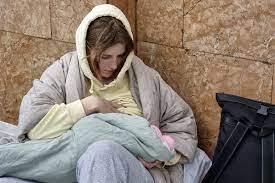Women solidarity, creative resistance, and the gendered dimension of the war
The powerful photo of baby strollers left at the railway station in the Polish city of Przemyśl went viral and was widely shared on social media as a symbol of female solidarity and the camaraderie of motherhood par excellence. This ephemeral and spontaneous action of Polish mothers in supporting Ukrainian mothers who were forced to flee with their infants got me thinking about the gendered dimension of the war in Russian-occupied Ukraine.

[Baby stollers at the train station in Przemysl. @ Francesco Malavolta]
In the western patriarchal world, warfare has always been man’s domain. After the declaration of the martial law in Ukraine, male citizens aged of 18 to 60 were prohibited from leaving the country, and men with military experience were conscripted into military service.
Taking up arms for women is voluntarily and historically not unusual in this country’s traditions. No doubt, women play crucial and diverse roles in the war by defending the nation, whether fighting with weapons, protecting cultural heritage, or rescuing children and elderly people.

[Lesia Khomenko_‘Max is in the Army’ series (2022) © Courtesy the artist]
The art scene in Ukraine has undergone a radical transformation as well. The cellars of the museums and exhibition spaces have been turned into shelters; artists are building anti-tank obstacles; art production has moved to social media platforms and is functioning as war news reports. Some of them have already become public art works to raise awareness of the inhumanity of the war.
- Kinder Album_Ukraine will Resist
- Kateryna Lysovenko
- Alevtina kakhidze, Freiraum Ukraine, Vienna
- Alevtina Kakhidze
- Yermilov Centre (Kharkiv)
- Voloshyn Gallery (Kyiv), exhibition of Oleksiy Sai
At the same time, ephemeral actions, solidarity gestures, and amateur images, endowed with artistic value, are having a social and cultural impact. However, the “authors” in many cases remain unknown heroes; they are only referred to as a “woman from St. Petersburg on the subway”, a “group of female volunteers”, or “Polish mothers”.
Ukrainian Madonna
Women, who are mothers and caregivers escaping the country with children, are struggling to preserve the future of the Ukrainian nation by keeping upcoming generations safe. In this context, the empty strollers left on the train station can be seen as an anti-war memorial. Instead of glorifying the masculine character of the war – as most war memorials do – this ephemeral public artwork makes nonviolence, the ability to care, to create and procreate, visible.
The traditional caring role attributed essentially to women takes on a radical meaning in the context of war, and at the same time, we are witnessing the birth of a national myth. Ukrainian mothers became not only victims but heroes of the war, the hope of the rebirth of the country, survival of the nation, persistence of national identity – values Putin and his followers call into question.
The photo taken by Hungarian journalist András Földes (telex.hu) of a mother breastfeeding her child in a shelter in Kiev shows how images are circulating and gaining unforeseeable impact in visual culture. The iconic photo alluding to Holy Mary was reused by the press office of the Vatican as the cover image of Pope Francis’ speech condemning the war. The same image was appropriated by a group of artists in the style of Ukrainian icon paintings and labeled as “Kyiv Madonna” or “Ukrainian Madonna”. The artistic quality of these visual reflections is less interesting, but the mechanism of how these images have been created has contributed to the birth of the myth of the Ukrainian Mother.
- Photo of András Földes, journalist, telex.hu
- Kyiv Madonna, @ Maryna Sopomenykova
The image of the young mother in a hoodie represents an everyday woman, one of us, without home, without husband, without appropriate circumstances to live and nurture her child. The power of these visual reflections is rooted in the strong cult of Mary in the Orthodox Church and in the honoring of icons depicting the mother of God. The tragedy of the entire Ukrainian nation and the gendered dimension of the war has been captured in these images: while men are fighting at the front, women are left alone and unprotected to shoulder the burden of life. (Wartime sexual violence, the destruction of the bodies of women, mothers, and daughters leave a deep imprint on the collective body of society. Rape is used as a double weapon.)
The Russian invasion of Ukraine has been ongoing for more than 2 months; since then, dramatic economic, social, demographic, and cultural changes are taking place in the country and beyond. Such narratives, like the solidarity of Polish mothers and the image of the Ukrainian Madonna, are shaping the cultural psychology of not only a traumatized Ukrainian society, but hopefully attitudes toward women globally.
By: Viktoria Popovics













WOMEN AT WAR
curated by Monika Fabijanska
presented by Fridman Gallery (NYC)
in collaboration with Voloshyn Gallery (Kyiv)
July 6 – August 26, 2022
Yevgenia Belorusets, Oksana Chepelyk, Olia Fedorova, Alena Grom, Zhanna Kadyrova, Alevtina Kakhidze, Dana Kavelina, Lesia Khomenko, Vlada Ralko, Anna Scherbyna, Kateryna Yermolaeva, and Alla Horska (1929-1970)
Women at War features works by a selection of the leading contemporary women artists working in Ukraine, and provides a context for the current war, as represented in art across media. Several works in the exhibition were made after February 24, 2022, when Russia began full-scale invasion; others date from the eight years of war following the annexation of Crimea and the creation of separatist “republics” in Donbas in 2014.
See more on https://www.monikafabijanska.com/